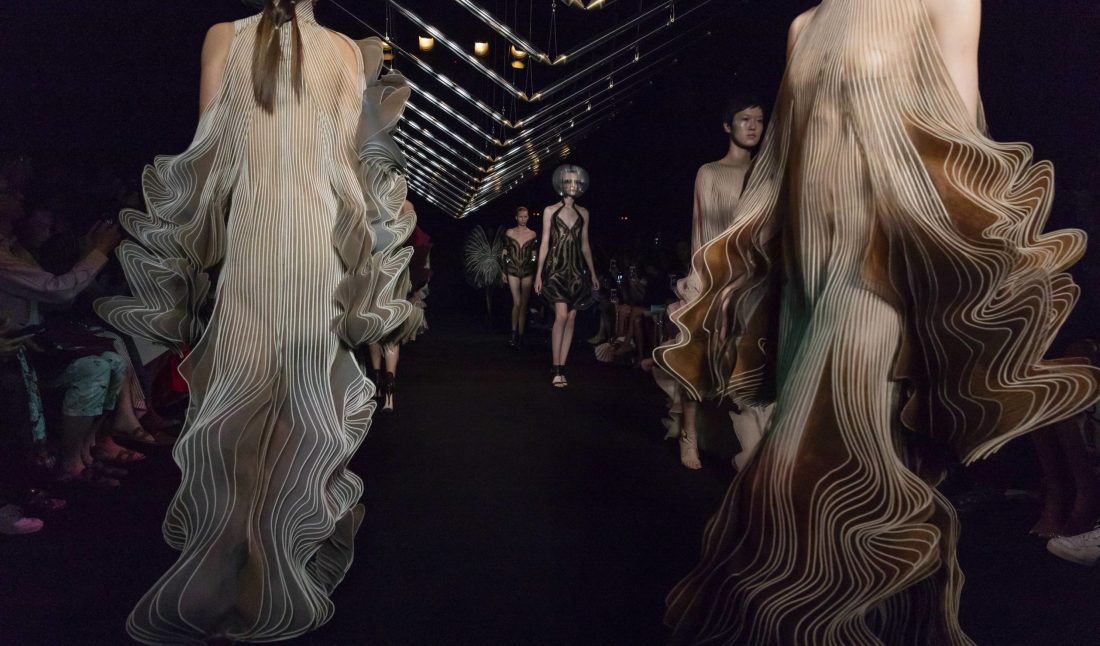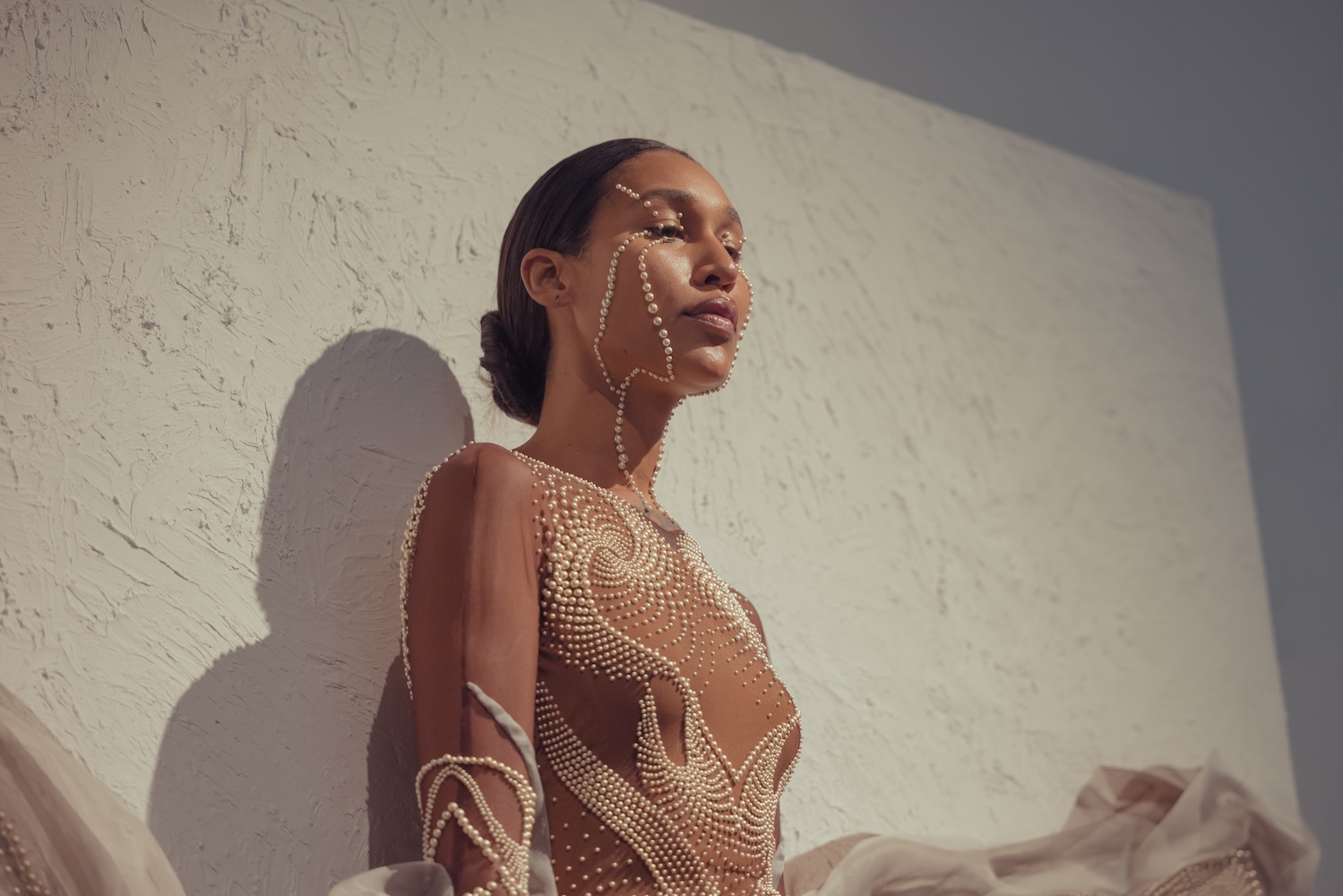On July 2 in Paris, the designer Iris van Herpen presented her latest haute couture collection, entitled “Syntopia.” Heat-bonded and laser-cut corset dresses with dreamy organza details floated down the runway, and for the occasion, In 20 Steps, a glass kinetic installation by Studio Drift, hung above.
Originally seen in Studio Drift’s premiere solo museum exhibition, “Coded Nature,” at the Stedelijk Museum Amsterdam (April 25–August 26, 2018), In 20 Steps inspired Van Herpen’s collection. With “Syntopia,” the designers combined the elements of flight with technology to create an unforgettable alliance of art and fashion. No stranger to experimenting with materials or applied science, Van Herpen has yet again pushed the boundaries of the impossible for a new sculptural collection.
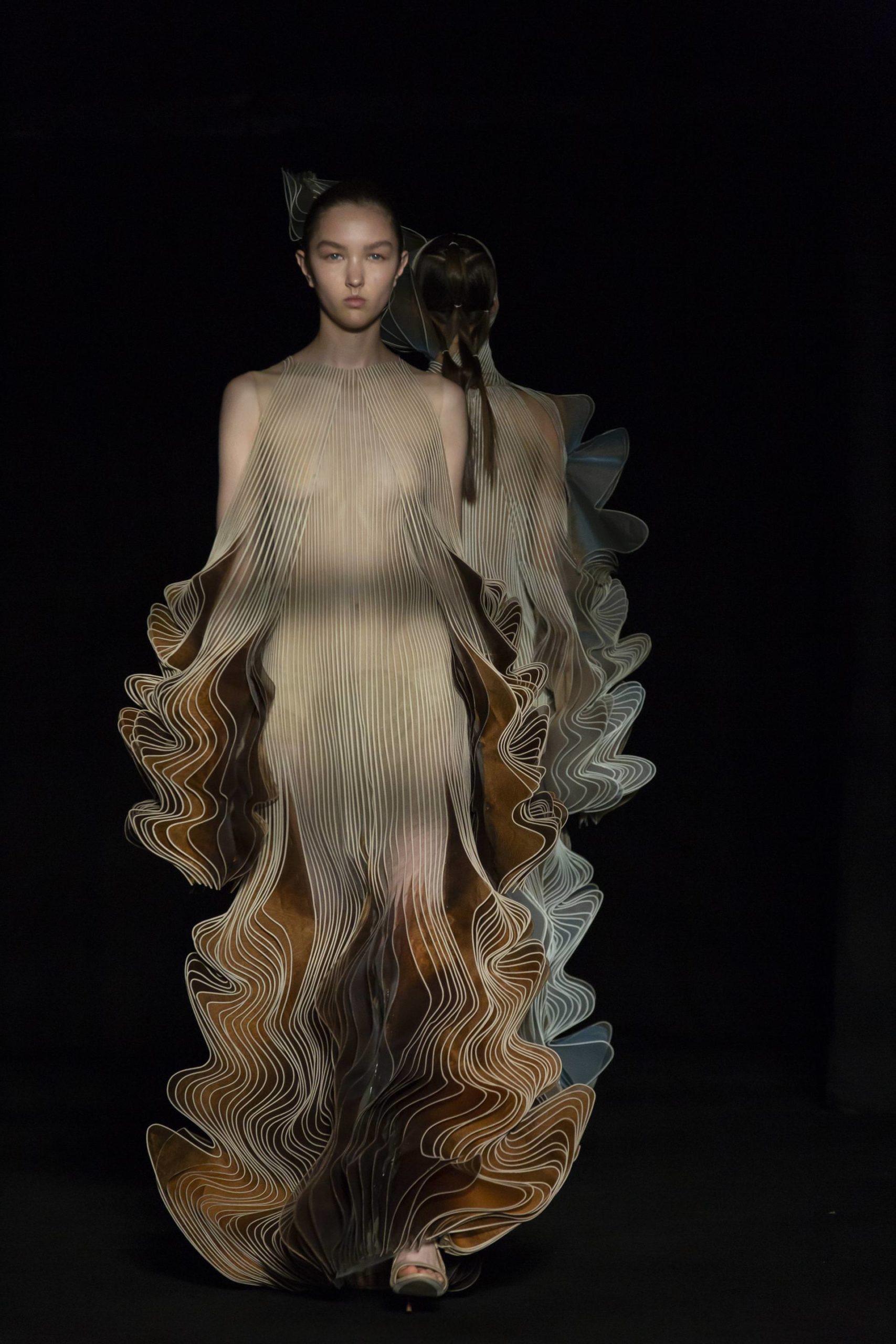 Photo by Paul Blind.
Photo by Paul Blind.Courtesy of Iris van Herpen.
Whitewall spoke with the creators about working with biological research and tech-forward design, and what the future may hold.
WHITEWALL: Iris, your latest collection was inspired by Studio Drift’s “Coded Nature” exhibition, and the human desire to fly. What was your starting point?
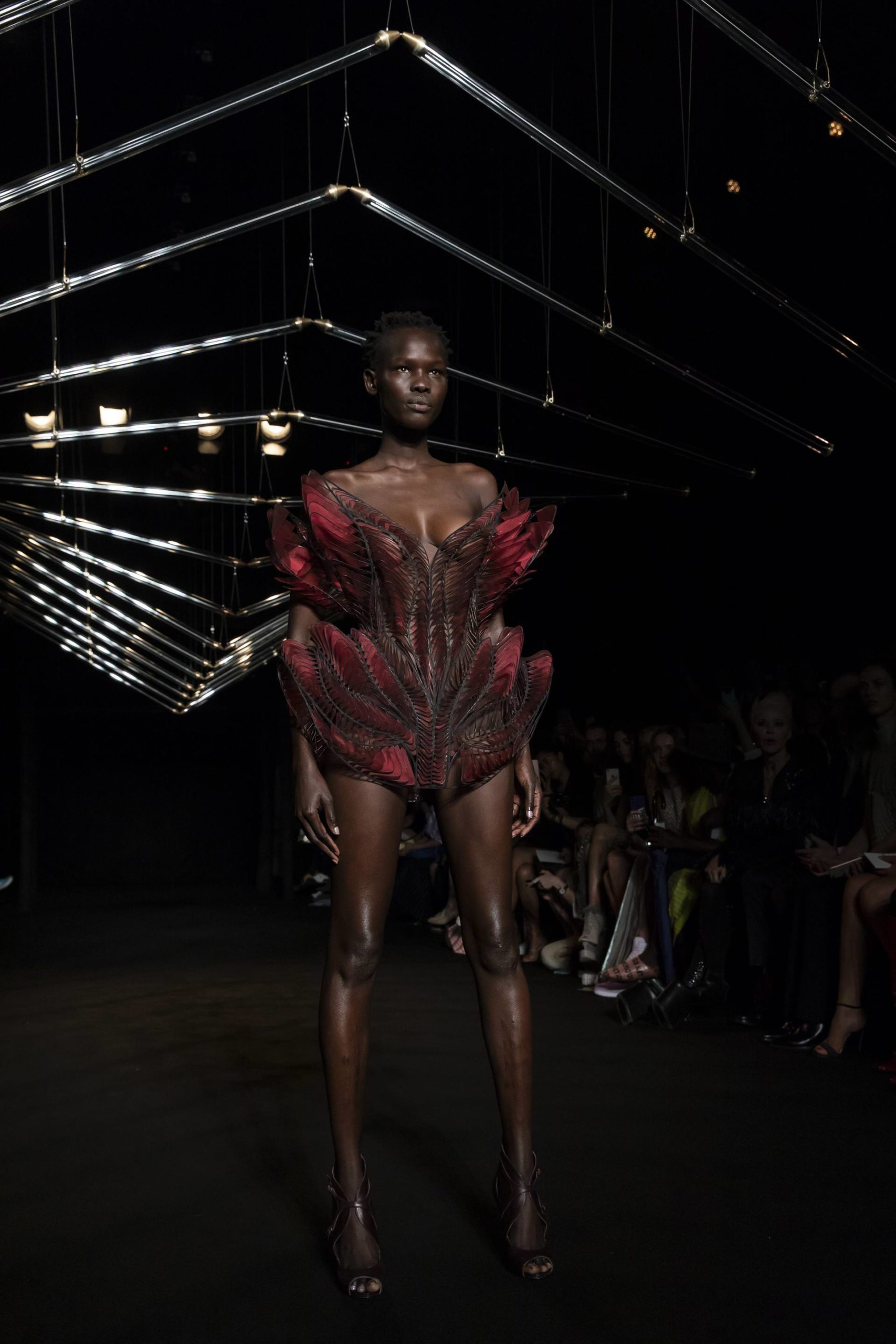 Photo by Paul Blind.
Photo by Paul Blind.Courtesy of Iris van Herpen.
IRIS VAN HERPEN: I saw their beautiful kinetic installation In 20 Steps that is made of 20 delicate glass wings that represent all the different steps of flying, in an abstract way. I felt very inspired by how natural and synthetic this “being” felt to me. At the same time, I was reading the book Life 3.0 by MIT scientist Max Tegmark, which discusses our future with artificial intelligence.
Blending both, I started to explore the new worlds that arise within synthetic biology and the intertwining relationships between the organic and the inorganic more deeply. This stage was the seed of “Syntopia.” Then I focused on translating the fragility and power I felt within this shift into my design process.
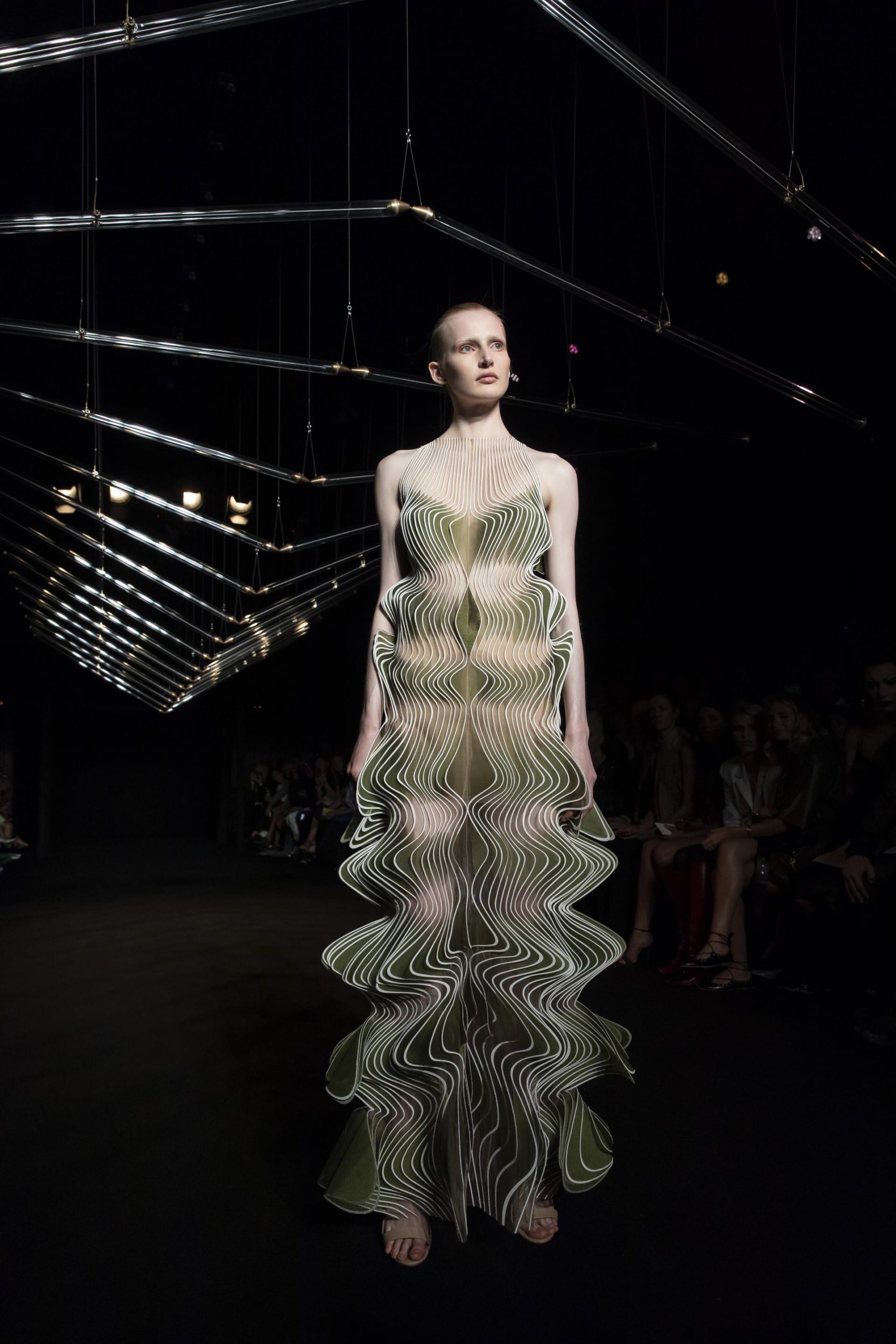 Photo by Paul Blind.
Photo by Paul Blind.Courtesy of Iris van Herpen.
WW: The mini Mimesis corset dresses are made from birds’ soundwave patterns, out of various materials to mimic the architecture behind a feather. Tell us a bit about how the patterns were obtained and applied and how the pieces were constructed.
IVH: We looked at existing bird sound patterns and, with those in mind, we started drawing new versions of them on the computers, to then laser-cut them. To be able to be as delicate as I had in mind, we had to heat-bond the cotton to the Mylar before laser-cutting. After cutting, we added a piece of silk organza inside each laser-cut line so that each of the hundreds of lines would start to move and open up like a flower. This is one of the most delicate jobs we’ve ever done. The laser-cut lines are only 1.5 millimeters, so to get the organza to fit inside precisely really asked for the most patience of the team ever.
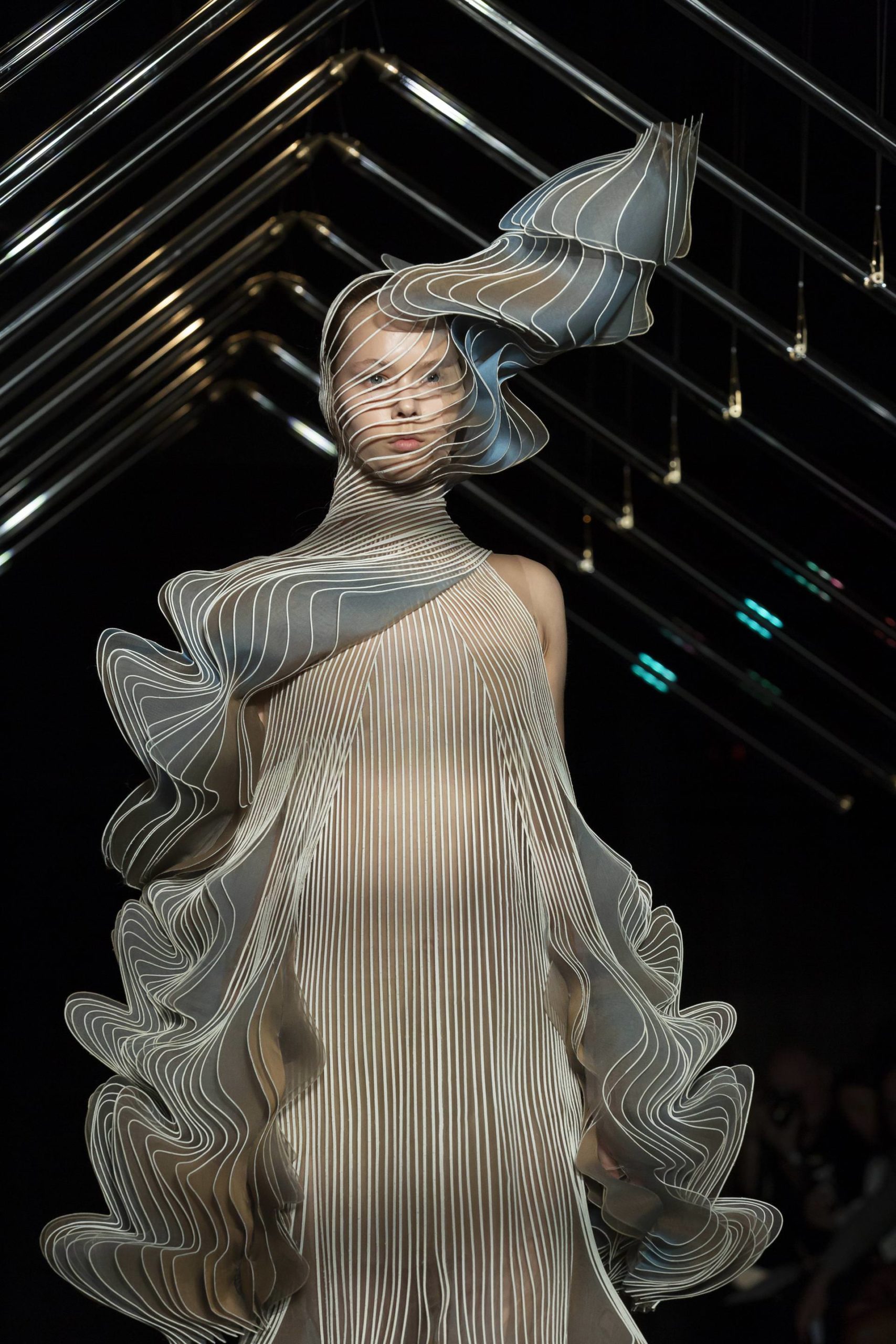 Photo by Paul Blind.
Photo by Paul Blind.Courtesy of Iris van Herpen.
WW: You’ve previously said that a collection defines you as a person at the time of its making. What does this collection say about you today?
IVH: I must say this collection came from deep down. The process for me was harder than usual, and I think that was because the subject is so unknown. In some collections I refer to the past, in some to the current, but the few collections that hint toward the future are the most difficult . . . probably because my process is so intuitive. I drape and design each look with my own hands on a mannequin. It’s simple and purely based on how I feel. And toward the future, my feelings are unknown. “Syntopia” shows my own duality. I look at the world both very positively and very worried—like a magnet attracting and repulsing, flying and yang needing each other.
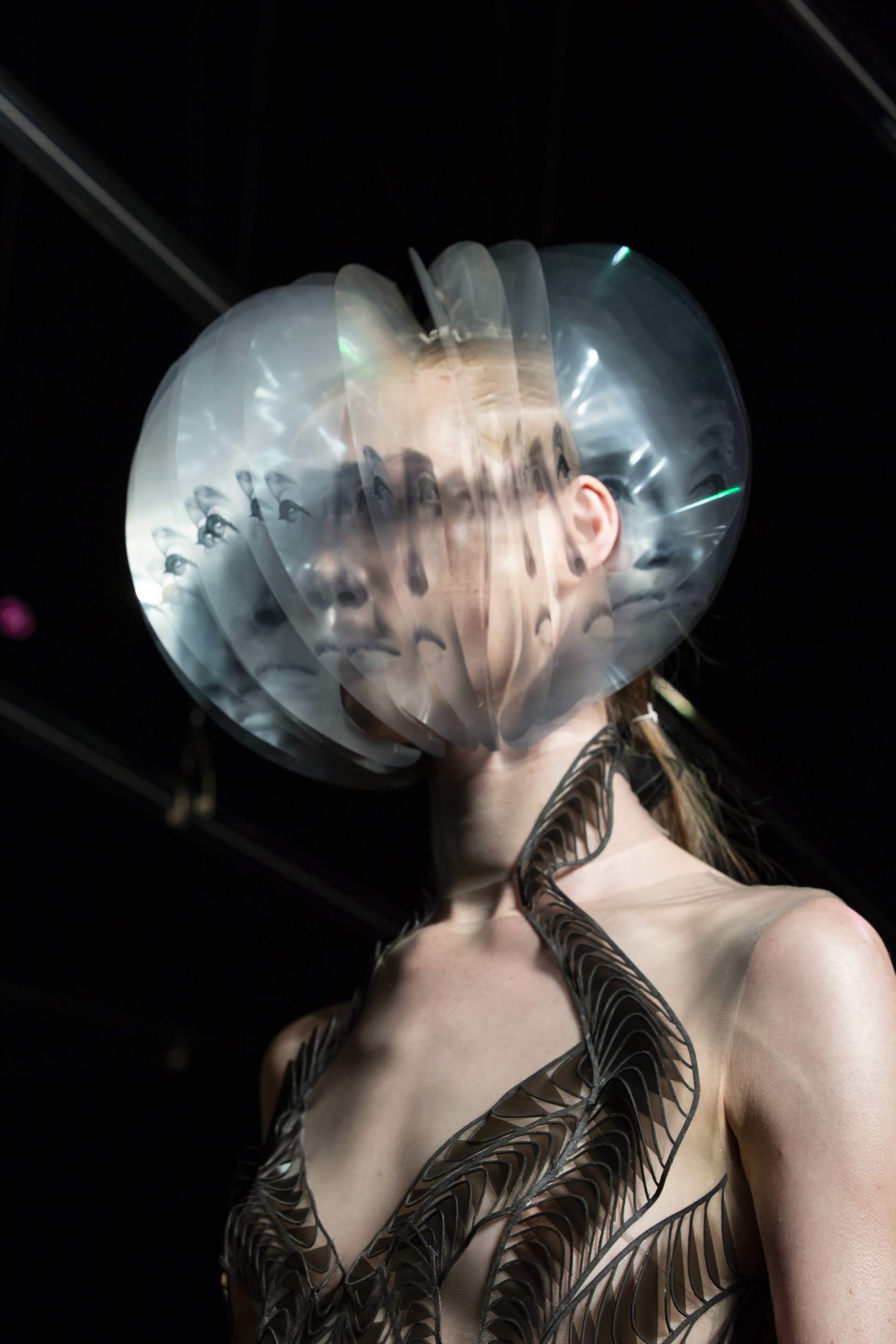 Photo by Paul Blind.
Photo by Paul Blind.Courtesy of Iris van Herpen.
WW: There are similarities between your practice, and Studio Drift’s. Why did you want to work with them?
IVH: When I was a child, I wanted to become a dancer. The transformation within movement has fascinated me ever since I practiced classical ballet. I felt hypnotized when I saw Studio Drift’s In 20 Steps installation. That [was the] same feeling of seeing a ballet piece for the first time, capturing the simplicity within movement so ingeniously and so delicately, that they inspired me to look at motion in a way I had never done before: super-zoomed-in, the movements within a second only. Seeing In 20 Steps also inspired me to look at the work of the scientist Étienne-Jules Marey and to look more closely at the draping of a garment through chronophotography. By slowing down time into split seconds, I started breaking down the usual draping of fabric, like Drift had done with their “bird.”
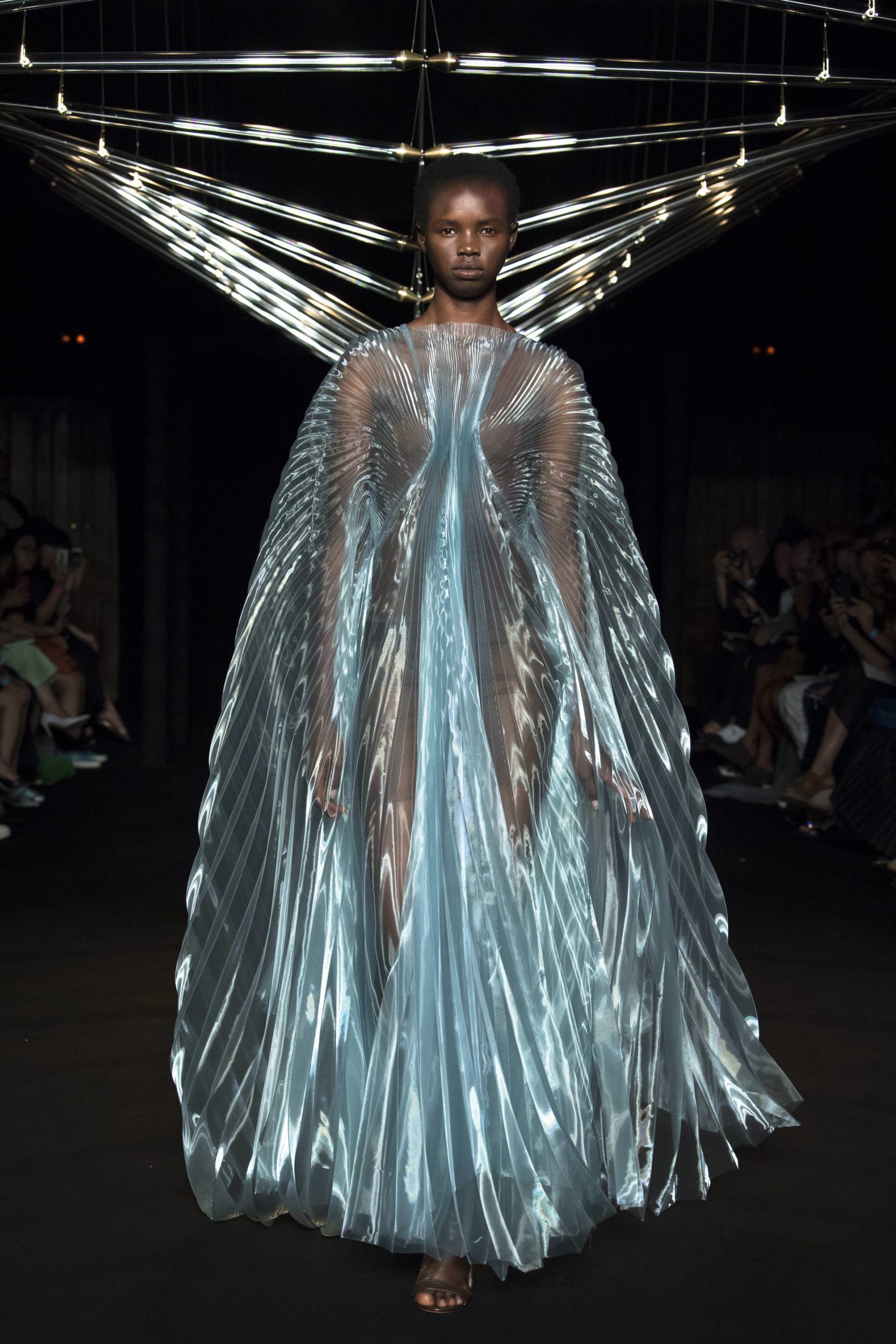 Photo by Yannis Vlamos.
Photo by Yannis Vlamos.Courtesy of Iris van Herpen.
WW: Is there a material you haven’t worked with yet but are interested in?
IVH: I am waiting for a meta-material scientist to crawl inside the mind of M. C. Escher, making an “infinity” material that, on a nano level, creates a kinetic loop movement so that the texture of the fabric is naturally changing.
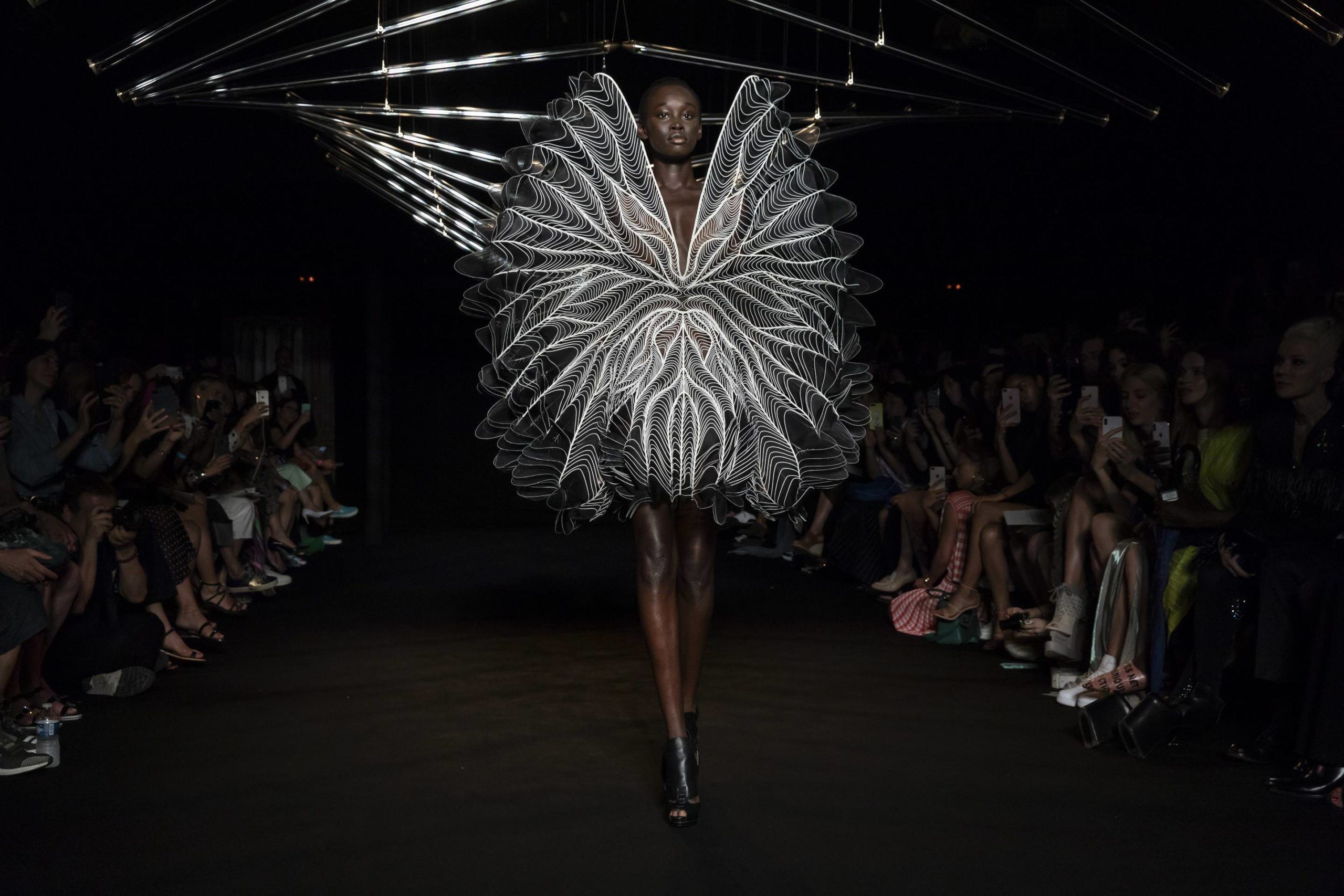 Photo by Paul Blind.
Photo by Paul Blind.Courtesy of Iris van Herpen.
WW: Your studio in Amsterdam is immersed in nature, along the water in a converted warehouse at the Old Wood Harbor. There you work among other artists and artisans like wood sculptors, graphic designers, piano tuners, and metalsmiths. How does your studio space affect how you work?
IVH: The view over the water influences me immensely. It speaks so quietly and peacefully. Every day I look at how the sun paints the different blues of the water and how the wind shapes the different water patterns. Seeing water move sometimes makes me feel useless as an artist, as nature is the most ingenious artist itself. But that feeling is encouraging at the same time. And the different artists and craftsmen around me also inspire me a lot. We often talk with them to find a solution for a material that doesn’t want to behave like we do—sharing knowledge from different disciplines is so helpful to move our process outside of the usual borders of our own knowledge and solutions.
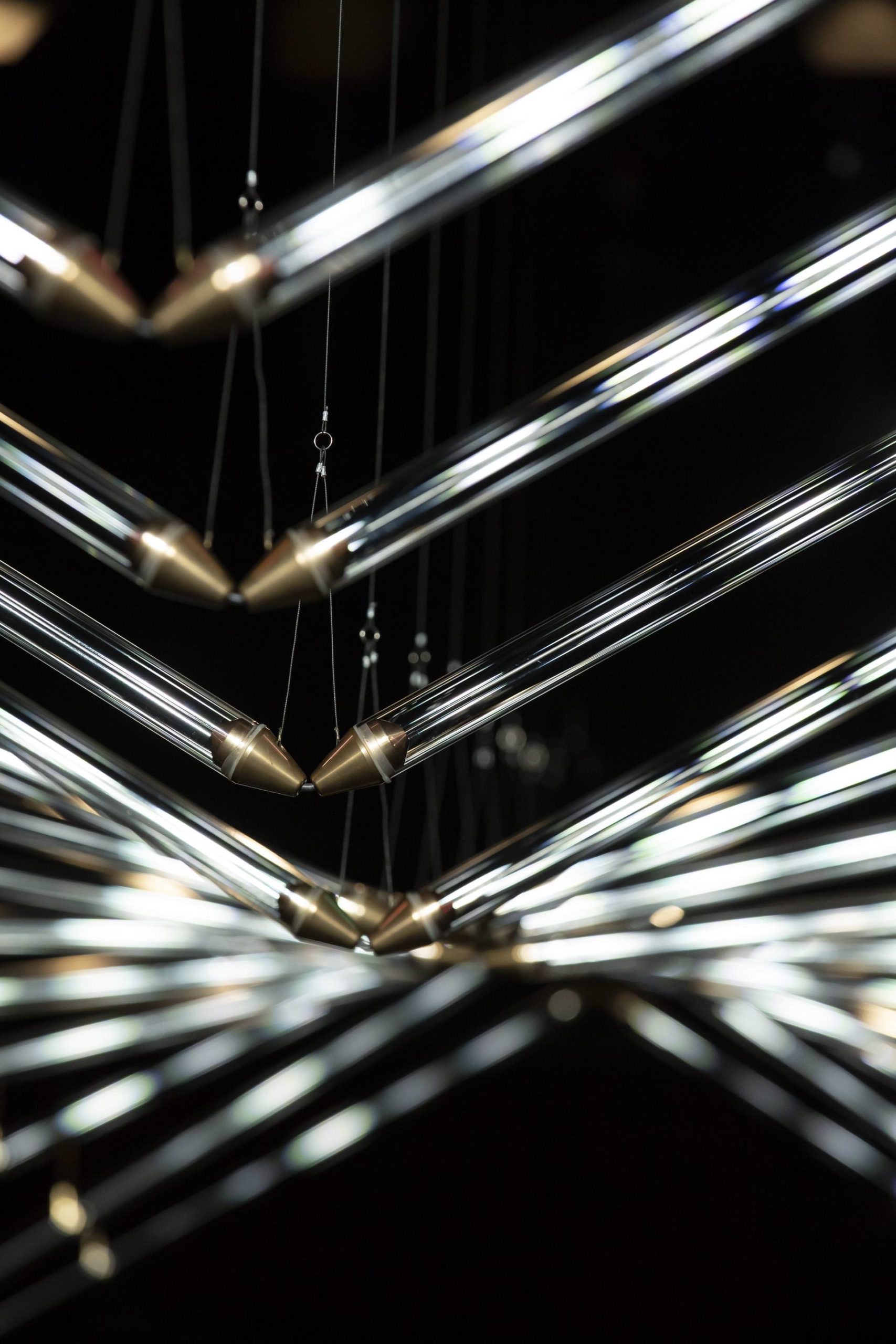 Photo by Paul Blind.
Photo by Paul Blind.In 20 Steps by Studio Drift.
Courtesy of Studio Drift and Iris van Herpen.
WW: What does the future hold?
IVH: I am really not able to see the future. I can only think about it. Perhaps what the future really holds is not intelligible for our present minds. What I hope is that artificial intelligence will help us overcome our big environmental flaws and we find ways to collaborate and live with nature more symbiotically.
WW: Ralph and Lonneke, Iris has been inspired by your work overall, but tell us a bit about In 20 Steps and why this was special.
STUDIO DRIFT: Iris is very much inspired by our work, and this work especially, because of how we translate natural processes by breathing life into delicate immersive sculptures through movement.
In 20 Steps is a tribute to evolution and the ultimate human desire to be able to fly. The work is reflecting natural pulsation in movement, light, and life. A cluster of glass elements is triggered to move in their natural speed. Whether they are waves, flying birds, or running men, all movements on earth can be seen as the carrier of innovation—a true desire for all species to deeply connect. For the show with Iris, we wanted the models to become one with the artwork, as one big breathing organism.
WW: How was this constructed?
SD: In 20 Steps is a spatial, kinetic installation constructed of 20 delicate glass wings that represent all the different steps of flying in an abstract way. Each element is powered by a motor and contains bronze joints. At the same time, the piece captures flight in a single moment. The glass emphasizes the fragility of the movement and of nature itself. Simultaneously, the way the moving glass breaks the natural light in the space and reflects it in moving rays mimics a celestial dance. The piece itself does not give light. It is only environmental light that is visible through the reflections in the moving glass.
WW: Your work has long explored the relationship between the possible and impossible, pushing boundaries with scientific reasoning and new technology. How is that expressed here?
SD: In 20 Steps is about the human desire to fly—one of the most impossible things for us as human beings. Humans don’t stop when they see impossibilities, but reach beyond their own skills. I think this work is showing the emotional impossibilities more than the technical.
Our work is never simple to create. All the glass wings have to move separately from each other and have to have the perfect harmony with the walking models. We mainly struggled with time issues and making the work look and function as simply as possible. For this, you first have to have a wide range of options, test things, and narrow them down. To make In 20 Steps interactive with the models, it was quite a challenge, as the human factor and differences between the models are not controllable, yet the artwork had to respond to that. We have tested endlessly to make it flawless.






